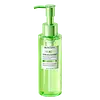What's inside
What's inside
 Key Ingredients
Key Ingredients

 Benefits
Benefits

 Concerns
Concerns

 Ingredients Side-by-side
Ingredients Side-by-side

Water
Skin ConditioningGlycerin
HumectantPalmitic Acid
EmollientLauric Acid
CleansingPotassium Hydroxide
BufferingStearic Acid
CleansingMyristic Acid
CleansingButylene Glycol
HumectantPotassium Cocoyl Glycinate
Potassium Chloride
Polyquaternium-7
Disodium EDTA
Citrus Paradisi Peel Oil
MaskingCitrus Aurantium Dulcis Peel Oil
MaskingPotassium Cocoate
EmulsifyingCoconut Acid
CleansingMethylparaben
PreservativeSodium Hyaluronate
HumectantEpilobium Fleischeri Extract
Skin ConditioningPropylparaben
PreservativeDisteardimonium Hectorite
StabilisingPotassium Sorbate
PreservativeCitric Acid
BufferingCamellia Sinensis Leaf Extract
AntimicrobialWater, Glycerin, Palmitic Acid, Lauric Acid, Potassium Hydroxide, Stearic Acid, Myristic Acid, Butylene Glycol, Potassium Cocoyl Glycinate, Potassium Chloride, Polyquaternium-7, Disodium EDTA, Citrus Paradisi Peel Oil, Citrus Aurantium Dulcis Peel Oil, Potassium Cocoate, Coconut Acid, Methylparaben, Sodium Hyaluronate, Epilobium Fleischeri Extract, Propylparaben, Disteardimonium Hectorite, Potassium Sorbate, Citric Acid, Camellia Sinensis Leaf Extract
Water
Skin ConditioningPotassium Cocoyl Glycinate
Hydrogenated Starch Hydrolysate
HumectantAcrylates/Steareth-20 Methacrylate Crosspolymer
Potassium Cocoate
EmulsifyingSodium Lauroamphoacetate
CleansingLauryl Hydroxysultaine
CleansingPhenoxyethanol
PreservativeErythritol
HumectantBetaine
HumectantCaprylyl Glycol
EmollientC12-13 Alketh-9
EmulsifyingParfum
MaskingPotassium Hydroxide
BufferingSodium Chloride
MaskingDisodium EDTA
Glycosyl Trehalose
Emulsion StabilisingDipropylene Glycol
HumectantQuaternium-73
Caramel
Cosmetic ColorantHydroxyacetophenone
AntioxidantSalicylic Acid
MaskingAllantoin
Skin ConditioningLactobionic Acid
BufferingLactic Acid
BufferingButylene Glycol
HumectantHydroxypropyl Cyclodextrin
MaskingCI 19140
Cosmetic ColorantCentella Asiatica Extract
Cleansing1,2-Hexanediol
Skin ConditioningCI 42100
Cosmetic ColorantEthylhexylglycerin
Skin ConditioningWater, Potassium Cocoyl Glycinate, Hydrogenated Starch Hydrolysate, Acrylates/Steareth-20 Methacrylate Crosspolymer, Potassium Cocoate, Sodium Lauroamphoacetate, Lauryl Hydroxysultaine, Phenoxyethanol, Erythritol, Betaine, Caprylyl Glycol, C12-13 Alketh-9, Parfum, Potassium Hydroxide, Sodium Chloride, Disodium EDTA, Glycosyl Trehalose, Dipropylene Glycol, Quaternium-73, Caramel, Hydroxyacetophenone, Salicylic Acid, Allantoin, Lactobionic Acid, Lactic Acid, Butylene Glycol, Hydroxypropyl Cyclodextrin, CI 19140, Centella Asiatica Extract, 1,2-Hexanediol, CI 42100, Ethylhexylglycerin
Ingredients Explained
These ingredients are found in both products.
Ingredients higher up in an ingredient list are typically present in a larger amount.
Butylene Glycol (or BG) is used within cosmetic products for a few different reasons:
Overall, Butylene Glycol is a safe and well-rounded ingredient that works well with other ingredients.
Though this ingredient works well with most skin types, some people with sensitive skin may experience a reaction such as allergic rashes, closed comedones, or itchiness.
Learn more about Butylene GlycolDisodium EDTA plays a role in making products more stable by aiding other preservatives.
It is a chelating agent, meaning it neutralizes metal ions that may be found in a product.
Disodium EDTA is a salt of edetic acid and is found to be safe in cosmetic ingredients.
Learn more about Disodium EDTAThis ingredient is the potassium salt of coconut acid. Coconut acid is created by mixing fatty acids from coconut oil.
It is an emulsifier, surfactant, and cleanser. According to a manufacturer, it contains glycerin.
Potassium Cocoyl Glycinate is an amino acid-based surfactant and cleaning agent. This ingredient can be derived from animals or plants. It may also be synthetically created from fatty acids of the coconut and glycine.
Potassium Cocoyl Glycinate is a gentle surfactant. Surfactants help gather the dirt, oil, and other pollutants from your skin to be rinsed away. It is a mild cleanser and naturally produces foam.
Potassium hydroxide is commonly known as caustic potash. It is used to fix the pH of a product or as a cleaning agent in soap. In cleansers, it is used for the saponification of oils.
Sapnification is the process of creating fatty acid metal salts from triglycerides and a strong base. During this process, Potassium Hydroxide is used up and is not present in the final product.
Using high concentrations of Potassium Hydroxide have shown to irritate the skin.
Learn more about Potassium HydroxideWater. It's the most common cosmetic ingredient of all. You'll usually see it at the top of ingredient lists, meaning that it makes up the largest part of the product.
So why is it so popular? Water most often acts as a solvent - this means that it helps dissolve other ingredients into the formulation.
You'll also recognize water as that liquid we all need to stay alive. If you see this, drink a glass of water. Stay hydrated!
Learn more about Water